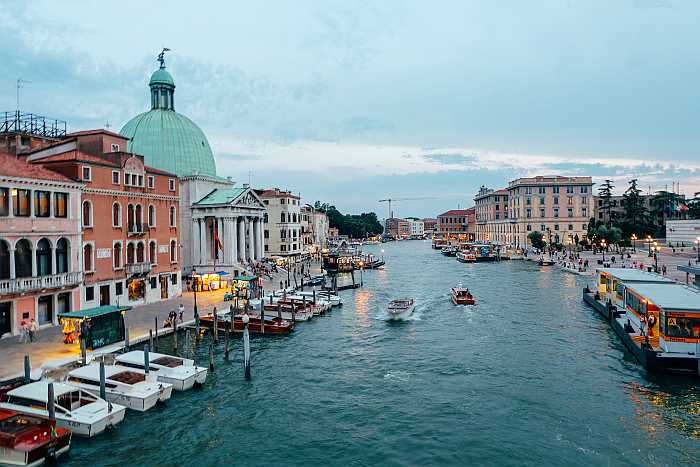
Sunset over canal in Venice (Photo: Envato)
Discover charming towns, historic gems, and hidden corners of the Veneto — all just a short ride from Venice. Plan ahead for kosher food and explore Italy beyond the canals.
Around cities like Rome, Florence, Venice, and many others in Italy, there are places that tourists—especially those from abroad—often don’t know about, or may have only vaguely heard of, without ever actually visiting them.
A trip to these destinations is truly worthwhile and offers the chance to explore magical places just a short distance from the cities where you're staying—all in the span of a single day.
This is the third in a series of "suggestions" for day trips or, if you prefer, explorations to take from these iconic cities.
Important: Please note that the destinations featured in the Day Trips series do not have kosher restaurants or shops. We recommend purchasing kosher food in Venice before you travel. Venice has a few kosher restaurants, and Chabad offers takeaway meals. Some kosher products can also be found in local supermarkets—contact Chabad for up-to-date details.
Enchanting Escapes from Venice: Seven Day Trips of Art, Romance, and Timeless Beauty
Beyond the shimmering canals of Venice lies a land of rolling hills, ancient towns, and villas that whisper stories of the Renaissance. From poetic hilltops to Roman arenas, these seven day trips from Venice invite travelers to experience the Veneto’s quiet majesty — a journey through history, art, and the simple pleasures of Italian life.
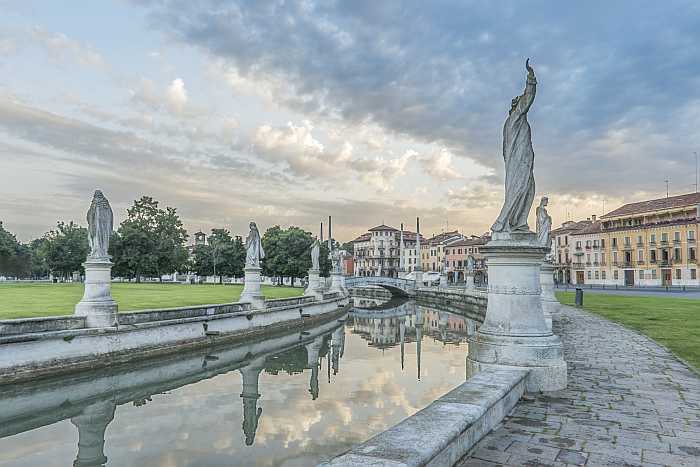

The Prato della Valle town square in Padua (Photo: Envato)
1. Padua – A City of Saints, Science, and Frescoes
Travel time: 25–30 minutes by train from Venice
Just a short train ride from Venice lies Padua (Padova), a city where medieval faith and Renaissance intellect intertwine. The heart of the city beats around the Basilica of Saint Anthony, one of Europe’s great pilgrimage sites, where pilgrims have come for centuries to touch the saint’s tomb and seek his miracles. Step inside, and you’ll be surrounded by sculpted marble by Donatello and the soft glow of flickering votive candles.
But Padua isn’t only about devotion — it’s also a city of learning. Founded in 1222, the University of Padua is one of the oldest in the world. Here, Galilei once lectured on the nature of the stars, and the world’s first anatomical theatre still stands, a testament to the dawn of modern science.
Art lovers will find heaven in the Scrovegni Chapel, where Giotto’s frescoes mark the birth of Renaissance art — angels that weep, devils that gnash their teeth, and a breathtakingly human portrayal of divine stories. Padua is a city where reason, art, and faith coexist in timeless harmony.
Beyond its walls of faith and learning, Padua also invites leisurely discovery. Stroll across Prato della Valle, one of Europe’s largest and most beautiful squares — an immense oval surrounded by a serene canal, bridges and statues of scholars, artists, and heroes. Once a swampy area outside the city, its major redesign began in 1775, led by Andrea Memmo, a Venetian nobleman and reformer who was then the governor of Padua. He envisioned turning the neglected swamp into an elegant public space reflecting Enlightenment ideals of order, beauty, and civic pride.
Then wander into the Orto Botanico di Padova, the world’s oldest university botanical garden (1545), where science and serenity still flourish side by side.
The Jewish Heritage of Padua – A Legacy of Learning and Resilience
Hidden among the arcaded streets near Via San Martino e Solferino, the Jewish Ghetto of Padua offers a quiet yet profound journey through history. Established in 1603 under Venetian rule, it was one of the earliest enclosed ghettos in northern Italy — a place of both confinement and community.
Despite restrictions, Padua’s Jewish residents built a vibrant intellectual life. The city’s University of Padua was unique in Renaissance Europe for welcoming Jewish students, and many studied medicine there, becoming renowned physicians throughout the continent.
At the heart of the old ghetto stands the Italian Synagogue, a small 16th-century jewel rebuilt after World War II. Its wood-paneled interior, warm with gilded details and Hebrew inscriptions, reflects both humility and grace. Nearby, a plaque commemorates the lives lost during the Shoah, while the community still gathers here for services and festivals, keeping a centuries-old tradition alive.
Just outside the historic quarter, the Jewish Cemetery — one of the oldest in Europe, dating back to the beginning of 1500 — rests quietly beneath cypress trees, its weathered tombstones inscribed with the elegant Hebrew of Padua’s scholars and doctors. In Padua, several famous rabbis are buried, including Rav Katzenellenbogen, known as the MaHaRam of Padua (1482–1565), and the renowned Rav Isaac ben Judah Abrabanel (1437–1508).
Why go: To witness where Western art and science took their first steps into modernity.
Insider tip: Book tickets to the Scrovegni Chapel in advance — entry is limited to protect the fragile frescoes.
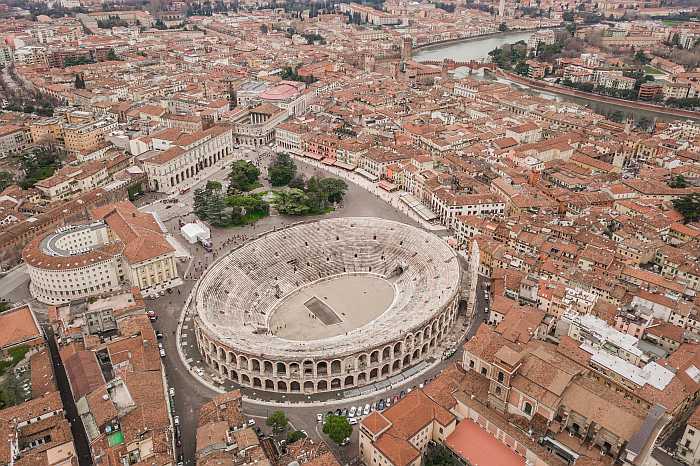
Arena di Verona (Photo: Envato)
2. Verona – The City of Love and Ancient Stones
Travel time: 1 hour 10 minutes by train from Venice
Verona feels like a stage set for romance — and in many ways, it is. Shakespeare’s immortal lovers, Romeo and Juliet, were born here in the imagination, and their story has left an indelible mark on the city. Visitors still crowd beneath Juliet’s balcony, touching the bronze statue of the heroine for luck in love.
But Verona’s true drama is older — and grander. The Arena di Verona, a Roman amphitheater still in use after nearly two millennia, hosts open-air opera performances under the summer stars. When the orchestra begins and the first notes soar across the ancient stone, time itself seems to stop.
Wander through Piazza delle Erbe, once a Roman forum, now a colorful market square lined with frescoed façades. Climb up to Castel San Pietro for a sweeping view of the Adige River curling through terracotta rooftops. Verona is a city where past and present dance hand in hand — a living love letter to beauty and endurance.
The Jewish Heritage of Verona – Between Memory and Beauty
Verona’s Jewish Ghetto, established in 1599, lies discreetly in the heart of the old city, just steps from Piazza delle Erbe. Today, its narrow lanes — Vicolo Crocioni, Vicolo Gatto, and Via Mazzini — are lined with cafés and boutiques, but their stones still whisper stories of a once-thriving community.
For over two centuries, the ghetto remained enclosed by gates, which were only dismantled after Napoleon’s arrival in 1797, when Jewish citizens were granted equality and freedom of movement.
The Synagogue of Verona, inaugurated in 1864, stands as a symbol of that newfound liberty. Designed in a refined neoclassical style, its façade is simple, but inside you’ll find an atmosphere of intimate grandeur — a sanctuary of marble columns, soft light, and the scent of polished wood. The community that gathers here today is small but active, preserving both memory and faith.
A few steps away, plaques mark the names of Veronese Jews deported during the Holocaust, reminders of a dark chapter in a city otherwise known for love and beauty. To walk these streets with awareness is to honor both.
Why go: To blend history, music, and romance in one unforgettable day.
Insider tip: Visit in early evening — when the sun sets on the Arena’s marble, the city glows like amber.

View of Vicenza from Santuario della Madonna di Monte Berico (Photo: Ввласенко, CC BY-SA 3.0, via Wikimedia Commons)

View of Vicenza from Santuario della Madonna di Monte Berico (Photo: Ввласенко, CC BY-SA 3.0, via Wikimedia Commons)
3. Vicenza – The City of Palladio’s Perfect Proportions
Travel time: 1 hour 15 minutes by train from Venice
Vicenza is a temple of architecture — serene, elegant, and perfectly composed. The city owes its splendor to Andrea Palladio, the 16th-century genius who shaped Western architecture. His influence extends as far as Thomas Jefferson’s Monticello and countless neoclassical buildings across Europe and America.
Start at Piazza dei Signori, where the Basilica Palladiana dominates the square with its graceful loggias. Then follow the Corso Palladio, lined with noble palaces, to the crown jewel: the Teatro Olimpico, the world’s first covered theater, with a permanent stage set that mimics a classical city in perspective — an illusion that still dazzles today.
Just outside the city, the countryside hides Palladio’s villas — including La Rotonda, a perfectly symmetrical masterpiece that seems to float amid the rolling hills. Vicenza is a quiet marvel, a place where geometry becomes poetry and harmony feels divine.
Why go: To walk through the birthplace of classical architecture.
Insider tip: Climb Monte Berico for sweeping views of Vicenza framed by the Palladian skyline.
4. Colli Euganei – Hills of Wine, Poetry, and Thermal Bliss
Travel time: About 1 hour by car from Venice
South of Padua rise the Euganean Hills, a gentle volcanic landscape beloved by poets and princes alike. Petrarch, the father of Renaissance humanism, chose the hilltop village of Arquà Petrarca as his final home, and you can still visit his perfectly preserved medieval house, where manuscripts and memories linger.
These hills are dotted with vineyards that produce excellent wines — such as Fior d’Arancio, a fragrant white with notes of citrus and honey — and thermal springs that bubble beneath towns like Abano Terme and Montegrotto Terme, renowned since Roman times. While kosher versions of Fior d’Arancio exist, they’re unlikely to be found locally. Ancient emperors once bathed here, and today’s travelers can still soak in the same healing waters surrounded by cypress and olive trees.
Drive or cycle through winding roads that reveal castles, monasteries, and panoramic views of the Veneto plain. The Euganean Hills are where the soul slows down — a place of nature, serenity, and quiet luxury.
Why go: To unwind among volcanic hills, historic villas, and ancient spas that have soothed travelers since Roman times — a haven for slow exploration and scenic drives.
Insider tip: End your visit in Abano Terme with a sunset soak at one of the thermal pools, surrounded by the scent of pine and cypress.
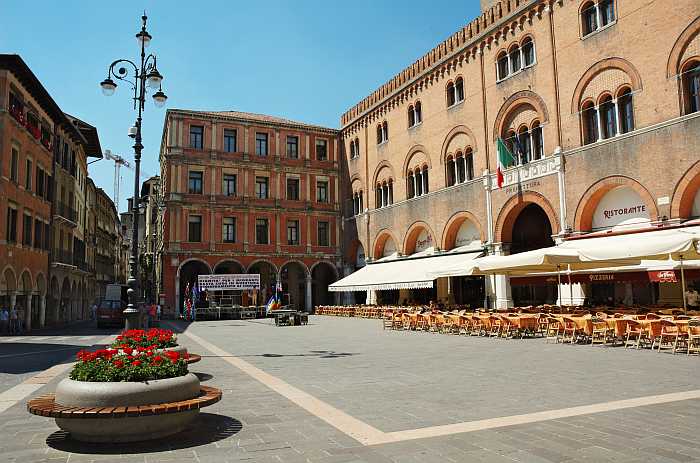
Piazza dei Signori, Treviso (Photo: Gary Houston, CC0, via Wikimedia Commons)
5. Treviso – Canals, Frescoes, and the Art of La Dolce Vita
Travel time: About 40 minutes by car from Venice
Often called “Little Venice,” Treviso is a graceful town of canals, cobbled streets, and medieval charm — but without the crowds. Water glides beneath low bridges and pastel houses, while bicycles and laughter fill the air.
The Piazza dei Signori is the city’s gathering place, lined with cafés and historic façades, where locals linger over conversation and the easy rhythm of daily life. Don’t miss the Duomo’s frescoes by Titian, or the Museo di Santa Caterina, a hidden gem filled with Renaissance art.
Treviso is also the birthplace of two icons of Italian pleasure: Tiramisù and Prosecco. While kosher versions of these classics aren’t available locally, you can often find kosher takes on them in Italy’s kosher restaurants — a sweet (and bubbly) way to experience Treviso’s legacy.
Charming, walkable, and deliciously authentic, Treviso captures the Veneto at its most genuine.
Why go: To experience a quieter, more authentic side of Veneto life — where Renaissance art, gentle waterways, and café culture blend in perfect balance.
Insider tip: Plan your visit for Friday morning, when the open-air market fills the canals with color and life, and locals gather to shop before the weekend.
6. Asolo and Its Plateau – The City of a Hundred Horizons
Travel time: 1 hour 15 minutes by train from Venice
Perched on a hillside like a vision from a dream, Asolo has long enchanted artists, queens, and poets. Known as the “City of a Hundred Horizons” for its endless views, it once hosted Queen Caterina Cornaro, the exiled queen of Cyprus, who turned her court here into a Renaissance salon. Later, Robert Browning and Eleonora Duse found inspiration in its quiet beauty.
Wander through flower-lined streets and shaded arcades, visit the Castle of Caterina Cornaro, and sip a glass of local Asolo Prosecco as you gaze across rolling vineyards and mountains. The nearby Asolo Plateau offers hiking paths, ancient hermitages, and small villages that seem untouched by time.
Asolo is not just a place to see — it’s a place to feel, where every view invites contemplation and every breeze carries the poetry of the past.
Why go: To step into a storybook hill town loved by poets and queens, where every turn reveals breathtaking views and timeless elegance.
Insider tip: Climb to Rocca di Asolo for panoramic views stretching from the Dolomites to the Venetian plain — best enjoyed near sunset.
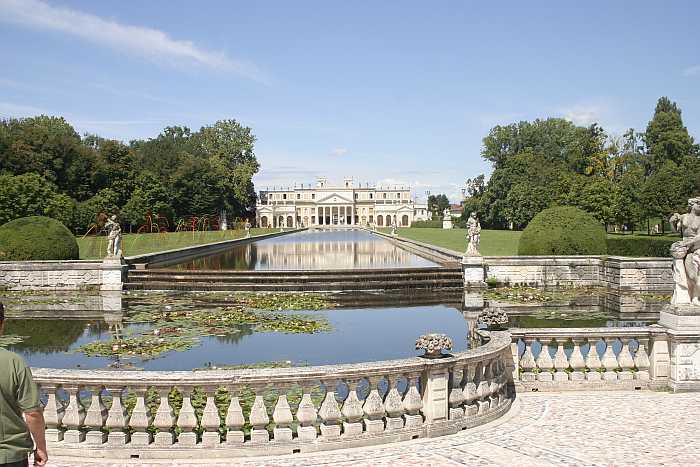
Villa Pisani in Stra (Photo: Grahamec, CC BY-SA 3.0, via Wikimedia Commons)

Villa Pisani in Stra (Photo: Grahamec, CC BY-SA 3.0, via Wikimedia Commons)
7. Riviera del Brenta – The Venetian Nobility’s Grand Escape
Travel time: About 20 minutes by car from Venice
Between Venice and Padua stretches the Riviera del Brenta, a waterway lined with opulent Venetian villas — the summer retreats of the republic’s aristocracy. In the 16th and 17th centuries, noble families would sail along this canal from Venice aboard decorated boats called burchielli, escaping the city’s heat for their elegant country estates.
The most magnificent of them all is Villa Pisani in Stra, known as the “Queen of the Villas.” Its grand staircase, frescoed ballroom, and playful hedge maze evoke the glory days of the Venetian Republic. Along the route, you’ll also find Villa Foscari “La Malcontenta”, designed by Palladio, whose restrained elegance contrasts beautifully with the lush gardens and reflective waters.
Today, you can follow the same route by car, bicycle, or even boat, gliding through landscapes that seem unchanged for centuries. The Riviera del Brenta is a living museum of aristocratic leisure — a golden corridor between two Renaissance worlds
Conclusion
Each of these towns offers its own charm, from canals and art to quiet piazzas and countryside views — all just a short trip from Venice. Keep in mind that kosher options aren’t available in these smaller destinations, so it’s best to pack what you need before heading out.
For tips on where to find kosher food, check out our guide to kosher food in Venice — the perfect starting point before setting off on your day-trip adventures.
More from Our Italy Day Trips Series
Continue your journey through Italy with the other guides in this series:
- Day Trips from Rome – uncover ancient towns, hilltop villages, and Jewish heritage sites around the Eternal City.
- Beyond Florence: Tuscany’s Hidden Gems – explore charming hill towns, vineyards, and Renaissance treasures across Tuscany.
Andrea Alcalay from La Tour I-Talya. LaTour I-Talya is a project established and managed by a team of Italian Jews working together with one of the largest and most prestigious Italian Tour Operators. LaTour I-Talya specializes in tour packages which focus on the amazingly rich Jewish historical and cultural heritage found throughout Italy — and the many lesser-known gems that exist off the beaten tourist paths.